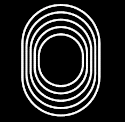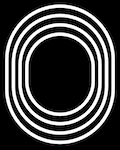
 What can you see? The disc (left) shows a pattern that can be interpreted as a racetrack. If the disc rotates slowly (right), the racetrack appears to wobble around the centre, i.e. it appears to be deformed. The disc with this effect was developed by Duncan (1975), inspired by Musatti’s description of the stereokinetic effect.
What can you see? The disc (left) shows a pattern that can be interpreted as a racetrack. If the disc rotates slowly (right), the racetrack appears to wobble around the centre, i.e. it appears to be deformed. The disc with this effect was developed by Duncan (1975), inspired by Musatti’s description of the stereokinetic effect.
What can you do? With the n_tracks-slider or with the up/down buttons you can set up to 50 tracks. The speed of rotation is adjusted with the angle slider (-10 ≤ angle ≤ 10). A fine adjustment of the rotation in steps of 0.25 can be made with the right/left buttons. The length of the straight lines is defined with length, the radius of the curves with radius. The width of the tracks is defined with linewidth. By changing these variables, you can investigate which shapes of the tracks show the wobble effect. Can the effect still be seen with faster rotations?
Interestingly, the effect disappears when the lines are broken. You can fade in such gaps if you set the switch interruption to 1. You can change the width of the gaps with the gap-slider.
What else can you do? For better clarity, several other values are hidden. If you select the Variables palette in the Snap!-programming environment, you can unhide and reactivate them: delta_l, which is the difference between the length of adjacent tracks, delta_r, which is the difference between the radii of the curves of adjacent tracks. Finally, with bg_color (0 ≤ bg_color ≤ 99) the background colour just as with line_color (0 ≤ line_color ≤ 99) the line color can also be changed.
Related topics: Duchamps Rotoreliefs, Mach discs
References:
Duncan, F. (1975). Kinetic art: On my psychokinematic objects. Leonardo 8:97–101.
